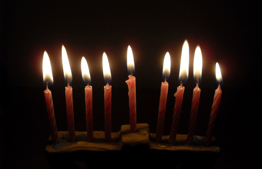Parashat Vayera: The Overturning of Sodom—an Educational Scar in the Land of Israel

Hashem notifies Avraham that He will overturn Sodom. The reasons for sharing this with him mentioned in the Torah and in Rashi are different, but essentially they are complementary.
Abstract: Hashem notifies Avraham that He will overturn Sodom. The reasons for sharing this with him mentioned in the Torah and in Rashi are different, but essentially they are complementary. Avraham, as the ultimate advocate of righteousness and justice would not be guilty of personal bias. Moreover, the creation of a scar in the country’s landscape has bearing on the holy task of Avraham and his descendants in the Land of Israel, yet it can also serve as a warning against social corruption. Until today it is possible to see the harmful effect of a depraved society on the world, manifested in the ecological phenomena at the Dead Sea.
A visit to the ruins of Zoar, the last city remaining of the “cities of the plain,” teach us about the time for bi’ur (removal or destruction) of dates from all of the Land of Israel, and also about the city that was destroyed in unknown circumstances at an unknown date.
The overturning of Sodom: an educational scar in the Land of Israel
And Hashem said: Shall I conceal from Avraham what I am doing, now that Avraham is surely to become a great and mighty nation, and all the nations of the earth shall bless themselves by him? For I have loved him, because he commands his children and his household after him that they keep the way of Hashem, doing charity and justice, in order that Hashem might then bring upon Avraham that which He had spoken of him.
(Gen. 18: 17-19)
It would be improper for Me to do this thing without his knowledge. I gave him this land, and these five cities are his … I called him Avraham, the father of a multitude of nations. Now, can I destroy the sons without informing the father, who loves Me?
(Rashi, ibid., sv. asher ani ose).
The Torah's explanation vs. Rashi's
Hashem decides to let Avraham know of his intentions to overturn Sodom. The problem is that reason the Torah states for this is does not make sense at first glance. Just because Avraham is a righteous man, beloved by G-d, and will receive many blessings does it make it necessary to notify him of the major events that will transpire? What’s the connection? Does this turn Avraham into a member of “G-d’s Cabinet”?
Rashi offers a much more understandable explanation. The Land of Israel was promised to Avraham and all of humankind has become his children. In light of this, it is only right to let him know about an event that will damage his portion and harm his spiritual children. This answer certainly explains the matter very well. But there’s just one problem with it: it’s not written in the Torah. It seems that the Torah provides a different explanation entirely.
It looks as if the answer to this enigma can be found in the combination of these two explanations—that explicit in the Torah, and that of Rashi. The reason for informing Avraham is that while it is true that the country and the people are his, people can often be biased, and foreign and egoistic rationale can skew their thinking. Avraham is made of different stuff. He cares only about one thing: carrying out what is just and righteous. There is no concern that he will make irrelevant arguments.
The absence of a “Torah cadre” and insights from the situation at the Dead Sea
Moreover, the Land of Israel is supposed to serve as the venue for the resting of the Divine Presence, accomplished together with the Jewish people who have merited it. The creation of a hideous scar in the country’s landscape for all generations to come is not at all a trivial matter. On the other hand, though, since the true goal is to “command his children and his household after him that they keep the way of Hashem,” it could be that the very existence of this unsightly scar in the Land of Israel will become a warning to us not to degenerate into a corrupt society. It goes without saying that the very location of Sodom and its environs, at the lowest place in the world, contains more than a veiled hint at its moral essence. In this way, the overturning of Sodom can actually be beneficial. First, however, it was necessary to ensure that the society in Sodom was entirely corrupt, without even a small community—even a quorum—that could acts as a Torah cadre (garin Torani) that could save the depraved society. This explains Avraham’s strange negotiations with Hashem. From the moment that it became clear that there was not even one positive cadre, there was no longer any reason to save the area.
The fact that Avraham was promised the Land of Israel, and that he and his offspring are considered worthy, revered role models among the nations (“and all the nations of the earth shall bless themselves by him”) makes it possible for him to transmit this message to all of humanity. The fact that the Dead Sea is of international importance is not only in order to contribute to region’s financial income; rather, it provides a rare opportunity to show all of humankind what happens when the pillars of society are erected on corrupt foundations.
Ecological phenomena in the region also lead to a similar insight: the extent that human acts (especially major acts, performed by society at large and not necessarily be individuals) cause enormous changes that span for hundreds of kilometers from the point of human intervention. The damming of flow from the Kinneret with the Degania Dam has led to the gradual disappearance of the Dead Sea. The receding sea level makes it very dangerous to walk on the beach: people walking there can fall into a sinkhole that suddenly opens underneath their feet with no prior warning. It is only proper that in tours of the area (and any other area, for that matter) that tour guides not only discuss the natural explanations for the phenomena, but also insights that can teach the tourists to “keep the way of Hashem, doing charity and justice,” and follow in the footsteps of Avraham Avinu, the father of believers.
Zoar, City of Dates
One may eat dates until the last one is Zoar is gone. R. Shimon b. Gamliel states: One may eat [in reliance] on those on the kifin and not [in reliance] on those at the shitzin. (Tosefta Shvi’it 7: 15-16)
Zoar: the sign for biur of dates
The date for biur (removal or destruction) of fruit of the shemita year is generally different for the Judea, East of the Jordan River, and the Galilee regions; in any one of these areas it is forbidden to eat fruit that is no longer on the trees in the same region, even if it can be found in a different region. This rule does not apply for dates and olives, though. For these two fruit, even when there is one region where dates or olives can still be found on trees it is permissible to eat them all over Israel and it is not necessary to remove or destroy them.
Zoar is known in the Mishna as the City of Dates. It seems that in the area are the dates that are last to ripen. The Yerushalmi (Shevi’it 9c) cites Jericho instead of Zoar, however it seems that it is referring to the whole Dead Sea Valley (according to Prof. Felix on the Yerushalmi, ibid.), marked by an arid climate and very little precipitation. Therefore, despite the fact that dates ripen in the fall, they can remain on the palms (since dates are eaten primarily after they are dried on the trees) for a long time without rotting.
R. Shimon b. Gamliel adds another date-related halacha. At times dates fall at the base of the overarching boughs (kifin according to Rashbag). When the fruit is there, it is accessible to animals, so they still are not considered “gone for the beasts of the field,” and, in turn, they do not need to be removed or destroyed. On the other hand, when the dates fall on the shitzin, which are the thorny branches that protrude from the palm’s trunk, they become trapped there and animals cannot access them. This makes the dates “gone for the beasts of the field,” and when the dates in Zoar are only in the shitzin, the halacha of biur applies to all dates in the Land of Israel.
The remnant destroyed in unknown circumstances
Zoar, the sole remnant of the “five cities of the plain,” and according to Chazal, the youngest of them, continued to exist for years after its sister cities were overturned in one of the most famous events in the history of humankind. It was situated on the south-eastern side of the Dead Sea, several kilometers west of the Jordanian town As-Safi. During the Byzantine era (parallel the majority of the Talmudic era), the city was an administrative center; it appears on the Madaba Mosaic Map from the mid-sixth century CE surrounded by six palm trees. Several Jewish graves have been discovered there that date back to the times of the Talmud, with dates on them relating to the destruction of the Second Temple and the year in the shemita cycle.
Excavations of the area uncovered a Byzantine church built adjacent to a natural cave. The site was identified as the Lot Church, whereas the cave was identified as the one mentioned in this week’s Torah portion in relation to Lot’s acts with his daughters.
Historical accounts relate that during the Byzantine era, when the authorities forbade the Jews from going up to Jerusalem, Zoar became a pilgrimage site. Perhaps it was because Zoar was the closest Jewish center east of Jerusalem. The exact date and circumstances for its destruction are unknown.




